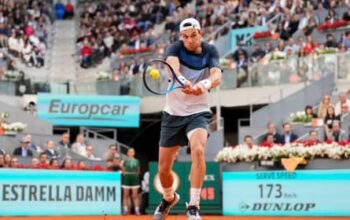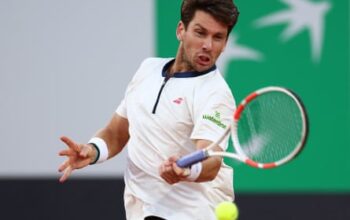N
This feat had never been achieved by any previous tennis player. It occurred in September during a tournament in Frankfurt. One player was Gaël Monfils, an experienced player known for his remarkable agility. On the opposing side was Andrey Rublev, who holds a position in the Top 10 world rankings.
Monfils was now serving, with Rublev in the lead. Standing at the baseline, he bounced the ball on his racket. Would he be able to make a comeback in the game?
Abruptly, electronic music blasted through the speakers of the arena. Monfils stood still and began to move to the beat. The crowd erupted in cheers. Rublev smiled. Monfils, on the other hand, was thoroughly enjoying himself. Before long, he tossed aside his racket and began spinning on the floor. It was as if a player from the Harlem Globetrotters had transitioned to tennis.
Monfils, speaking through Zoom, expresses his amusement and admits he is at a loss for words. He clarifies that the dance was entirely unplanned. If he had performed it at any other tournament, he would have faced immediate penalties. However, the tournament in Frankfurt was not like any other.
The Ultimate Tennis Showdown (UTS) was established in 2020 as a league. Following a break of two years, it returned in 2023. The upcoming tournament, known as the “Grand Final,” will take place in London from December 15th to 17th. In short, it can be described as a combination of the ATP Tour and the UFC.
The UTS matches are split into four rounds. In the event of a tie, players will enter into a sudden death situation. Losing two consecutive points will result in elimination. Adding to the excitement, a DJ plays music in between rallies and players can exchange playful banter during breaks. Players are also encouraged to express themselves during matches, as seen with Monfils’ performance. Along with Rublev and Monfils, the UTS lineup features top players like world No 3 Daniil Medvedev and rising stars like Ben Shelton, who reached the semi-finals of the 2023 US Open. Similar to UFC fights, the crowd is lively and energetic, although not as rowdy.
UTS was created by Patrick Mouratoglou, who was born in 1970 in France. He is considered the top figure in the world of tennis. He founded the Mouratoglou Academy and coached Serena Williams from 2012 to 2022, during which she won 10 grand slam singles titles. In recent years, he has gained a significant following on social media, earning the nickname “The Coach” and sharing advice with over a million followers.
To comprehend UTS, it is important to be familiar with Mouratoglou’s motivations. He states, “Tennis is my passion.” Currently, Mouratoglou is situated in his bright office on the sunny coast of France. With his voluminous silver hair and neatly trimmed facial hair, he resembles more of a movie star than a tennis instructor.
However, Mouratoglou’s appearance was not always so impressive. In his childhood, he admits to being introverted and frequently ill. As a result, he often felt isolated and alone, except when he was on the tennis court. Mouratoglou considers the tennis court to be his sanctuary. He quickly rose to the junior level and as a teenager, he became a highly regarded prospect in France, with a professional career on the horizon.
Afterwards, an event occurred that influenced the person Mouratoglou has become. His parents advised him to quit playing tennis. “My parents believed it was too risky. As a result, I was unable to continue my career, which caused a great deal of frustration.” Mouratoglou retired from the sport, knowing that he could have been successful.
If a young athlete is unable to become a professional due to a lack of skill, it can be difficult, but eventually they may come to accept it. If they are unable to turn pro due to an injury, they may attribute it to fate. However, if they are not allowed to pursue their dream, like in Mouratoglou’s situation, it can be devastating.
In his mid-20s, Mouratoglou rediscovered his passion for tennis and established his own academy. He expresses his deep love for the sport and his desire to promote its popularity.
This was the driving force behind the creation of UTS. For a while, Mouratoglou has been concerned about the aging fanbase of tennis. After conducting research, he discovered that the average age of a tennis viewer is 61. Younger audiences typically do not watch full tennis matches on TV.
Mouratoglou suggests that the lack of adaptation to the digital age in the sport has resulted in shorter attention spans. The format of tennis, which has remained largely unchanged for over a century, creates a disconnect with the younger generation that it is trying to attract.
Recently, various sports have attempted to narrow the gap in order to attract new viewers. One example is Major League Baseball, which has recently undergone a revamp of America’s beloved pastime. This includes changes such as reducing the time limit for pitchers to throw a pitch to 15-20 seconds and enlarging the bases to increase player accessibility. According to MLB commissioner Rob Manfred, these changes are in response to fans’ desire for a faster-paced game. Another sport that has made efforts to appeal to a wider audience is golf, which is typically associated with an older demographic. The new Saudi-backed tour, LIV Golf, has given the sport a makeover by implementing a shorter three-round format and relaxing the dress code for players. Additionally, music is now regularly played during games, in line with LIV’s slogan “Golf, but louder.” While MLB’s changes have generally been well-received by fans, LIV Golf has struggled to attract a dedicated audience, possibly due to allegations of sportswashing.

UTS can be described as a more exciting version of traditional tennis. Mouratoglou clarifies that it is not meant to replace the ATP Tour, as players can participate in both. Rather, it is intended to be a separate league with its own fan base. According to Mouratoglou, the idea behind UTS is to reimagine the sport of tennis, taking into account how people consume content in today’s world.
The scoring system in UTS matches differs from traditional tennis. Instead of sets and games, there are four “quarters.” To prevent matches from becoming too long, each quarter is only eight minutes. Similar to a tiebreak, players serve twice and points are tallied one by one. However, in UTS, players have the option to use a “bonus card,” which triples the value of the next point. At the end of the quarter, the player in the lead only needs one more point to win that quarter.
“Skip past the newsletter promotion.”
after newsletter promotion
The UTS events occur during a weekend, with players split into two groups. They compete against members of their group on both Friday and Saturday. The top two ranked players from each group then advance to the semi-finals and ultimately, the final on Sunday.
“I believe it’s enjoyable and fantastic,” expresses Christopher Clarey, the writer of The Master and a journalist who has covered tennis for over 30 years at the New York Times. He currently publishes Tennis & Beyond on Substack. “They have really considered some creative concepts,” Clarey adds. “You’re not completely altering the fundamental nature of tennis, but you’re introducing something that appears quite distinct.”
The game’s pace is significantly different. UTS players are limited to one serve instead of the usual two, and there is a maximum of 15 seconds between points. Clarey explains that tennis has a lot of downtime, which is a major issue. Mouratoglou believes that any breaks in the action can result in a loss of viewers. He describes traditional tennis as a marathon, while UTS is more of a sprint.
For players, that sprint is no walk in the park. “I found it very hard, very intense,” admits Monfils. “It was a different way of approaching the game … every point counts. We are under pressure because we have only one serve. And I found it very physical too, because we don’t get much respite.”
The outcome leads to very enjoyable tennis. There are even shots that are not typically seen in traditional tennis. When Mouratoglou created the UTS court, he set the net to end at the edge of the court instead of extending past it. This allows players to easily hit around the net – as Monfils did with a swift return in his match against Rublev. Monfils expresses his excitement about this new move in his repertoire, saying “It’s amazing. We have a lot of opportunities as soon as we move sideways, as soon as we hit with a lot of angles.”
However, according to Mouratoglou, showcasing exciting tennis matches is only one aspect of the larger picture. He believes that the narrative surrounding sports cannot solely revolve around two individuals playing tennis. In order to attract and engage new fans, there needs to be more depth and complexity, similar to the approach taken by UFC. This means highlighting the personal dynamics between athletes. As a result, each player is given a nickname, such as “La Monf” for Monfils, “The Chessmaster” for Medvedev, and “The Mountain” for Shelton. Whether these monikers are endearing or cheesy is subjective and based on personal preference.
During each quarter, there are interviews on the court where players can engage in friendly trash talk. This is just one aspect of UTS’s attempt to create a unique atmosphere. In traditional tennis, players strive to control their emotions, like the composed Roger Federer. However, in UTS, showing emotions is encouraged. According to Matthew Willis, author of The Racquet on Substack, fans of UTS may appreciate seeing players embrace their true selves on the court.
However, it’s not only the players who have more freedom, but also the audience. At its first event of the year in July in Los Angeles, UTS attracted 18,000 spectators and almost reached full capacity (there are plans to introduce a women’s version of the competition). Unlike at Wimbledon, where any noise is frowned upon, spectators are encouraged to make noise. Mouratoglou jokes, “Tennis is the only sport where you have to buy a ticket to be told to be quiet.”
The viewers are active on the internet as well. Enthusiasts have the option to watch live events on the UTS website. The most interesting moments are shared on social media, allowing younger viewers to discover tennis in shorter, more engaging clips, which is a departure from the traditional way of consuming the sport. According to UTS, their content has received over 55 million views on social media. It can be referred to as “TikTok tennis”.
The event may not have been well-received by everyone. The sport of tennis has a reputation for being conservative, and this is not the first time a sport has tried to revamp itself by adding elements like DJs and shortening game times in order to attract a younger audience. When UTS was first introduced in 2020, it faced strong criticism. Craig Gabriel, an Australian broadcaster, described it as a “joke.” (Gabriel declined an interview through his publicist.) Stuart Fraser, a correspondent for The Times who covers tennis, tweeted that the first day of UTS “will go down in history as the day tennis was altered in a negative way.” (Fraser did not respond to requests for an interview.)
Mouratoglou remains unperturbed. He dismisses criticism of new ideas, stating that their success will ultimately determine their worth. He emphasizes that it is not the individual or any commentary that matters, but rather how successful the idea will be.


